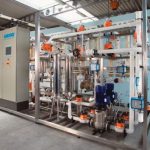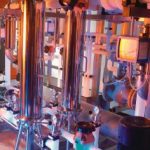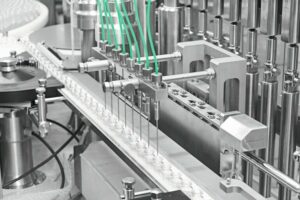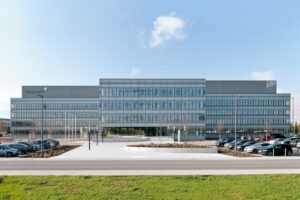The production of parenterals requires water for injections according to the applicable pharmacopoeia. For a long period water for injections was used too for all cleaning and rinsing processes. According to the United States and Japanese pharmacopeia state of the art membrane processes are allowed for the production of WFI, only the European pharmacopoeia dictates thermal distillation for this applications. Since the amendment in January 2002 the water quality Highly Purified Water (HPW) has been established as a substitute for WFI for rinsing up to the final rinse.
Ulrich Träger, GRD CE
The very high microbiological security of distillation requires several times higher investments and according operating expenses in comparison to membrane separation processes. Depending on the installation´s capacity, effective costs per litre thermal distilled WFI can be higher by multiplicand 4 to 10 as an identic quality HPW, conditioned by a modern membrane separation process. Further it must be considered that the portion of the necessary WFI for the direct product constitutes only a fraction of the quantity needed for the production. The cleaning processes in the product production (e.g. CIP, final rinse) often needs up to 85 % of the entire quantity of water.
As the microbiological action limit of PW (purified water) with <100 cfu/ml allows operation without additional disinfection or sanitisation procedures, the regulation for HPW limits the total count of bacteria to <10 cfu/100 ml which expresses 3-log lower. Therefore appropriate precautions have to be installed in order to prevent microbiological growing. This concerns naturally the entire purification system, i. e. from tap water connection to the last purification step.
The actual kind of treatment for HPW is not exactly defined in the European Pharmacopeia, but recommended as (… current production methods include for example double pass reverse osmosis coupled with other suitable techniques… ).
Applicable combinations
Due to the last ten years´ operational experience, especially as far as the restrictive conductivity requirements are concerned, the combination of reverse osmosis and electrochemical deionisation (CEDI) states out as the method of choice for PW. Although HPW-quality can be achieved provably by this combination, considering microbiological aspects, practical experience points at a further seperation step in form of a membrane. Reverse osmosis as well as the process of ultrafiltration appear preferable therefore.
Contrary to the reverse osmosis membrane, which, as a spiral wounded membrane, only can be used constructively in conjunction with seals (min. two O-rings), ultra filtration with it´s casted hollow fiber modules makes up a completely sealless system with according advantages and safeness. Another positive aspect of ultra filtration are the distinctly reduced pres-sures, so that often no additional pumps are necessary.
The expert for ultra pure water systems, Werner in Leverkusen (Germany), counts consciously on ultra filtration as the last purification step, especially due to the high microbiological requirements, for a reproducible integrity test and according safeness are guaranteed by this technology. In this installations asymmetrically constructed hollow fiber membranes with a cut-off of 6000 Daltons are used, which verifiable have a pyrogenic retention of 6-log.
With sanitization
Preventively, or if defined alert limits are exceeded, the whole system – besides the established chemical disinfection – can be undergone a fully automatic, thermal sanitization. The upstream reject system is used thereby for the optimization of operating expenses, as during stand-by-operation as well as during thermal sanitization a permanent recirculation without any waste water ammount is guaranteed.
Due to consistent usage of state-of-the-art membrane technology and appropriate CEDI-modules the thermal sanitization of HPW-systems is guaranteed at 85 °C with up to 150 cycles. In comparison with the validated chemical disinfection, which has been applied for many years, thermal treatment of a purification installation has obvious advantages for the user:
- no qualitative verification of rinsing times necessary
- most simple validating by the documented temperature profile
High pure PVDF
An additional feature of this generation of pharmaceutical installations is the ultra-pure-quality PVDF material. With it´s several times improved surface finish quality compared to high-grade stainless steel and it´s much more favourable physiological characteristics, this thermal stable material provides a significant surplus value to the user. The double packed material, produced under cleanroom conditions, is welded under laminarflow und doesn´t need any further treatment. The produced water quality is available immediately after the system-start without additional rinses.
Depending on the application, the system for storage and distribution, installed downstream of the actual purification, can be run on temperatures between 65 and 85 °C permanently, to prevent by 100 % any microbiological recontamination. If HPW is needed coldly for the actual process, a cold storage with weekly sanitization has been proved. Especially as far as the distribution-system is concerned, another decisive advantage of PVDF evinces. It is applicable at a temperature range of -20 to +140 °C. Just as all plastics, PVDF is a good thermal isolator, the thermal conductivity of 0.19 W/mK is several decimal powers lower than high-grade steel´s 250 W/mK. For this reason additional thermal isolations can be forgone at most PVDF systems. In that case, special attention must be put on planning and execution of the ring-lines, as PVDF-lines that transport hot water must be compensated by some angels because of the ten times higher thermal coefficient of expansion.
Many different purification installations with the combination of reverse osmosis – CEDI – ultra filtration with thermal sanitization put the concept successfully into practice: optimal purity and highest microbiological steadiness (<3 cfu/100 ml).
cpp 463
More about Werner
European Compliance Acadamy
Share:








